Introduction
This publication will help youth exhibitors determine how and where to purchase a project pig and provide information on what the student should look for when purchasing the pig in order to do well in a swine show. Youth interested in participating in a swine show will learn how to answer the following questions:
-
Where should I buy my project pig?
-
Should I contact a swine producer or work through my club or chapter to buy a group of pigs?
-
What breed or cross should I buy?
-
What should my pig look like on the day of the show?
-
How do I select a pig to fit the feeding period dictated by the show?
-
What traits will be important to evaluate as I choose my pig?
Youth interested in participating in a swine show should complete these steps before starting the project:
-
Search the Internet for resources from these livestock websites:
http://www.thejudgingconnection.com/education.php
http://www.breedersworld.com/ [25 October 2012]
2. Attend project pig selection clinics and workshops. You can contact your county or surrounding counties for potential programs.
3. Attend shows in your county or surrounding counties to observe how a show works.
4. Participate on your county livestock judging team.
5. Visit area producers.
At the end of this guide there is a space for you to record the activities you completed and write about how they helped you with your swine project.
Pig Selection FAQs
What are your goals for the youth market hog project?
If you want to learn how to raise a pig, have fun, and participate at the fair, then any healthy market hog from modern commercial genetics will provide that experience. But if you want to be competitive in the show you will need to consider several other factors when you choose your pig. These factors are discussed later in this publication.
How should I approach purchasing my first project pig?
If you are a first-time youth exhibitor, then you should visit with your County Extension Office to see if an Extension agent, volunteer leader, or agricultural instructor in your area customarily purchases a group of pigs for local youth. If this is case, then you should get an animal this way. This is the best option for first-year exhibitors who have no previous experience working with food animals. Youth exhibitors should be encouraged by leaders to work independently from the group once they have gained experience with the pig project.
What about a pig sale?
Youth prospect pig sales are very common in many areas of the country and are becoming more common in the southeastern United States. First-time youth exhibitors and their families should visit a prospect pig sale before going to a sale intending to purchase a pig. This will hopefully prevent families from being caught up in the excitement of the live auction and spending more money on a pig than they intend.
Where should I purchase project pigs?
You can avoid many problems by obtaining pigs from a reputable producer. Purchasing pigs directly off the farm reduces some risks of problems, as opposed to visiting a sale where there are pigs from multiple breeders. Pigs purchased from a sale will be stressed during handling and transportation, and exposed to pigs from other farms, making them more susceptible to becoming sick. Additionally, purchasing directly from the producer allows a better opportunity for the youth to build a relationship with the producer.
What things should I look for at the farm?
You may choose a pig with excellent genetics, but if the pig becomes sick, it will likely never reach its full potential. Therefore, you certainly want to start with a healthy pig.
Do not buy pigs that are coughing or scratching, or that look unthrifty. If more than 10%–20% of the producer's pigs appear sick during your visit, be very hesitant to purchase a pig at that location, even if the pig you select appears healthy. Ask the producer for specific information about the vaccination and parasite control program. If you are buying pigs from out of state, make sure you have proper health certification prior to coming home.
What daily gain should I expect?
It is best to use a conservative estimate to guard against sickness, poor quality feed, injuries, or other unplanned problems. Remember, it is easier to slow a pig's rate of gain than to increase it. A good rule of thumb is 1.7 pounds of gain per day for modern market hogs, with a range from 1.4 to 3 pounds per day.
What weight pig should I buy?
To answer this question you must know the following: 1) the length of the feeding period; 2) the expected daily gain; and 3) the ideal final show/slaughter weight. The product of the first two (length of the feeding period and the expected daily gain) will provide the total pounds gained during the feeding period. Then subtract the total pounds gained from the ideal final weight to calculate the purchase weight of the pig.
Students can estimate the ideal final show/slaughter weight by using the information in the "traits to evaluate" section of this guide (look under growth/rib capacity/volume, as well as leanness/maturity). Most modern pigs should have an estimated final show weight of at least 250 lbs.
Example:
100-day feeding period
2.0 lbs/day average daily gain
270 pounds ideal final weight
100 x 2.0 = 200 pounds gained during feeding period
270 - 200 = 70 pound purchase weight
Should I purchase a barrow or gilt?
Gilts (young females) will maintain lean growth longer than barrows (young castrated males). However, barrows should exhibit faster growth than gilts (National Pork Producer's Council 1995), so the decision is up to the exhibitor.
Should I purchase a purebred or crossbred pig?
Crossbred progeny from purebred parents are genetically superior to their parents, especially for lean growth, because of heterosis or hybrid vigor (Lush 1945; Olson 2008). If the show is divided by weight, then purebreds shown with crossbreds are at a genetic disadvantage (Olson 2008).
What other questions should I ask the producer?
-
What was this pig's farrowing date?
-
May I see the dam and/or sire?
-
How much does the pig weigh currently?
-
How have pigs from this sow performed previously?
Ideal Market Hog
Before you can select a young pig, you must first know what you are trying to produce. This is why it is good to know what an ideal market hog looks like.
What should my pig look like on the day of the show?
Symbol III is the ideal market hog that symbolizes profitability for every segment of the industry (Figure 1; National Pork Board 2005). According to the National Pork Board, "This hog has correctness of structure, production, performance, function, livability, attitude, health, optimum lean yield, and produces the best quality, safest pork that provides the optimum nutrients for human nutrition."
Some of the production criteria for this ideal barrow are listed below:
-
A live weight of 270 lbs by 156 days of age
-
A feed efficiency of 2.4 lbs of feed per lb of live weight
-
A 10th rib fat thickness of 0.70 in and loin eye area of 6.5 in2
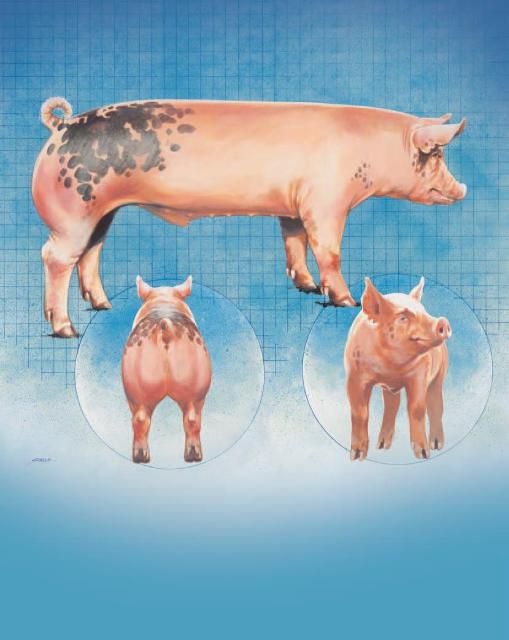
Credit: National Pork Board, 2005.
Parts of a pig
In order to discuss project pig selection, you must be familiar with the important body parts of the pig. These are shown in Figure 2.
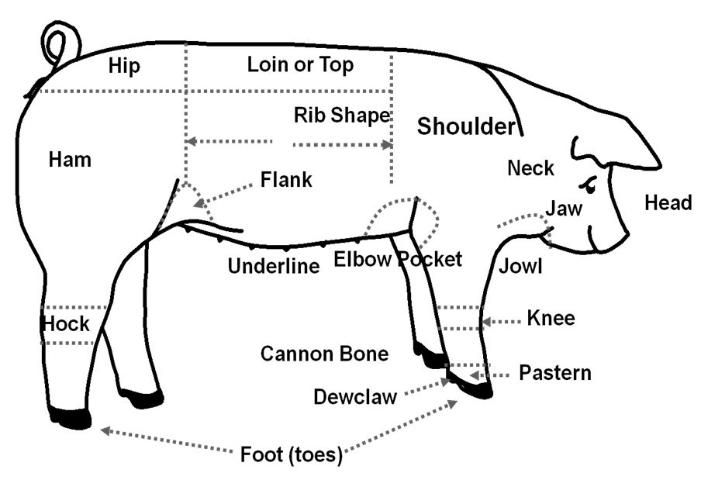
Credit: UF Animal Sciences
What traits will help me select a young pig that will mature to look similar to Symbol III?
The important traits to evaluate for young pigs are as follows:
-
Muscling
-
Growth/Rib Capacity/Volume
-
Leanness/Maturity
-
Design/Feet and Leg Soundness
Muscling
Muscling is the most important trait in a market animal and is also the easiest to evaluate. Muscle is what you are selling to the consumer; therefore, only pigs with above-average muscle thickness should be selected. Muscling is best evaluated by examining the hog from the ground up and from the rear forward. Heavy and well-muscled pigs will have a square, expressive shape when viewed from behind, with a deep groove down their top and a thick, full hip and ham. A light-muscled pig will have an inverted "V" shape when viewed from the rear. Figure 3 shows a very heavily muscled pig on the left, a well-muscled pig in the middle, and a very light-muscled pig on the right.
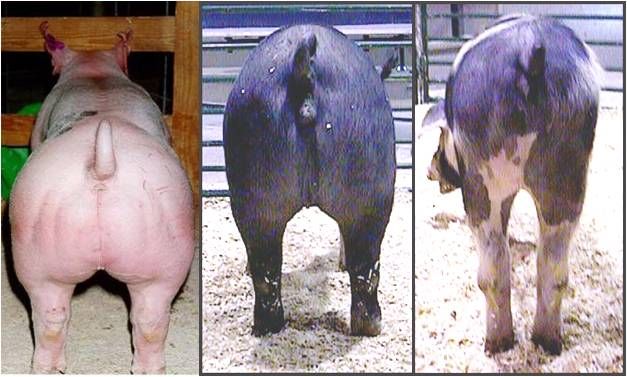
Credit: ADM Alliance Nutrition and University of Florida
Growth/Rib Capacity/Volume
It is very challenging to assess a young pig's genetic potential for growth. First, eliminate any pigs with obvious defects such as ruptures or structural defects. These will not perform normally and will certainly be discounted in the show ring and at the packer. Watch for the defects shown in Figure 4, which include a pig with an umbilical hernia on the left, a pig with a scrotal hernia in the middle, and a pig with kyphosis or "hump-back" on the right.

Credit: Dr. Todd See, North Carolina State University.
You certainly should ask the breeder about the growth of the sire and dam and select pigs from parents with above-average growth. Secondary indicators of growth include the length of the body, length of the cannon bone (collectively referred to as frame), cannon bone circumference, and rib capacity/volume.
Small-framed or very large-framed pigs will generally grow slower than pigs with a more "middle-of-the-road" frame size. Narrow-chested pigs with little body capacity and small cannon bone circumference will tend to grow slowly. Wide-chested and big-bodied pigs with very large cannon bone circumference will often be lower set and earlier maturing, and can grow slower, especially after they begin to deposit fat faster than muscle.
Figure 5 shows a gilt on the left whose secondary indicators of growth suggest she should be a nice project; a gilt in the middle that is too large-framed, low-volumed, and likely too slow-growing; and a barrow on the right that is too short-boned, too short-bodied and likely too slow-growing.

Credit: National Swine Registry
Figure 6 shows a pig on the left whose secondary indicators of growth suggest he should be a nice project; a low-volumed gilt in the middle that will likely remain lean to a heavy weight and will likely be too slow-growing; and a wide-chested, big-bodied barrow on the right that will likely have too much 10th rib fat thickness by 280 lbs.

Credit: National Swine Registry
Leanness/Maturity
Any pig with significant fat deposition at less than three months of age and less than 90 lbs is genetically inferior. However, length and height are good indicators of finishing weight. A tall, long-bodied pig will remain leaner to a heavier weight than a short, low-set pig. Assuming a similar environment, the barrows in Figure 7, from left to right, will have = 0.75 in fat thickness at the 10th rib by approximately 250, 275, and 290 lbs, respectively. Thus, the ideal final show/slaughter weights for the pigs depicted would be approximately 5 lbs less than each of those projected weights.

Credit: National Swine Registry
Differences in body volume and cannon bone circumference have become very popular points of selection for youth market hog judges over the past five years. These traits are relevant to growth and maturity when the animals evaluated display extensive variation, such as the two mature boars depicted in Figure 8. However, when the animals evaluated display less variation for these traits, the amount of emphasis placed on these traits becomes the opinion of individual judges.
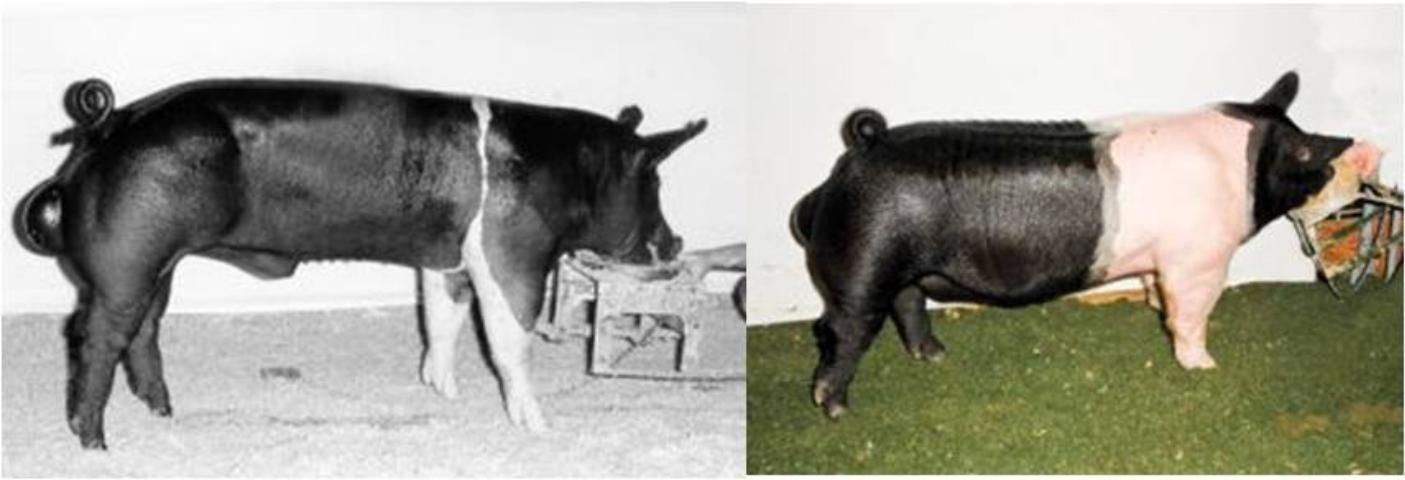
Credit: Swine Genetics International
Design/Feet and Leg Soundness
A correctly structured, well-designed pig with all joints at the proper angles will walk effortlessly and athletically, as if all the pieces fit together. The pig should hold its head up, have a level top line when walking, have clean joints with no evidence of swelling, and place its feet on all four corners of its body. Figure 9 depicts two pigs that appear to fit the previous description.

Credit: National Swine Registry
Pigs with structural problems severe enough to induce stress and obviously restrict mobility will have poorer growth than pigs with acceptable soundness. The more ill-structured the pig, the less likely they will become a heavy weight market hog and the more likely they will have problems during handling and loading at home, at the show, or during the pre-slaughter period (Ritter et al. 2006).
Figure 10 displays differences in front leg structure. The pig on the left has a correct angle to the shoulder, knee, and pastern; the pig in the middle is very straight-shouldered, over at the knee, and straight-pasterned; and the pig on the right has excessive slope to the shoulder, is set too far back at the knee, and is weak-pasterned. The structural defects shown in the middle and right picture could lead to pain from arthritic joints or an injured dew claw, potentially affecting growth performance.
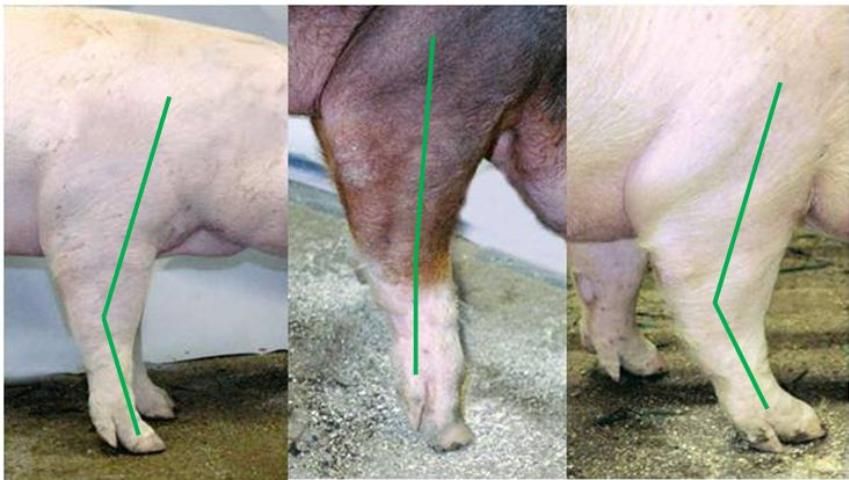
Credit: National Hog Farmer Magazine, 2009a.
Figure 11 displays differences in rear leg structure. The pig on the left has the correct set to the hip, hock, and pastern; the pig in the middle is very straight from the hock to the pastern; and the pig on the right has excess set to the hock and is weak-pasterned. The structural defects shown in the middle and right picture could lead to pain from arthritic joints or an injured dew claw, potentially affecting growth performance.
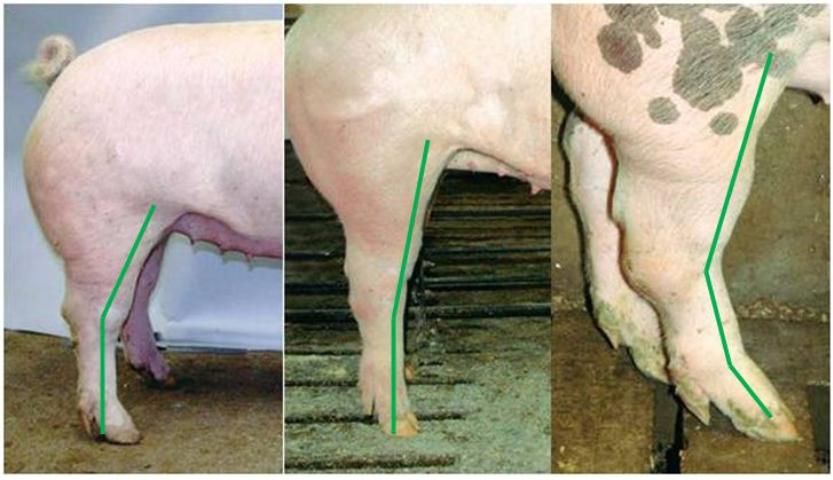
Credit: National Hog Farmer Magazine, 2009a.
Figure 12 displays differences of the feet and hocks. The foot on the left has even-sized toes with slight spread, and the proper slope and cushion to the pastern to allow the foot to set squarely on the floor. The next two feet display defects; the second foot has an ulceration above the toe and swelling around the knee, and the third foot has a much smaller inside toe. The hock displayed in the left picture shows swelling on the right hock, and the picture on the right displays swelling on the inside of the left hock. The defects shown in the four pictures on the right can lead to lameness, potentially affecting growth performance.

Credit: National Hog Farmer Magazine, 2009b.
Many pigs bred for youth shows are heavier muscled than most commercial pigs. This added muscle mass can negatively affect the pig's length and comfort of stride, but does not necessarily affect growth performance. Since a large percentage of pigs exhibited today have excellent carcass merit, judges of large, competitive market hog shows will place more emphasis on the differences in structural design and feet and leg soundness.
In Figure 13, the gilt on the left is too straight in her knee and hock, and her spine is too rigid; the next gilt is very short-hipped, straight-hocked, and appears possibly "too heavily muscled"; the next gilt is very broken in her top line affecting "how the pieces fit together" compared to the ideal; and the gilt on the right is very straight-shouldered and over at the knee.

Credit: National Swine Registry
The structural differences shown in these pictures could affect growth performance and would almost certainly affect the length and comfort of stride of the pigs as they grow and mature. Those differences could affect how each pig places competitively in the market hog show.
Summary
If youth exhibitors want to learn how to raise a pig, have fun, and participate in a pig show, they should select a healthy pig at the correct weight for the feeding period and make sure the pig appears to be growing normally and has no overt defects.
But if youth exhibitors are looking to be competitive in the pig show (in addition to having fun and learning about raising a pig), then they need to select a pig with all of the previous traits as well as other traits such as a good combination of muscle, volume, leanness/maturity, and feet and leg soundness.
Activity Summary
-
What activities did you complete to help you in selecting your show pig?
-
What breed or crossbreed did you decide on for the show?
-
What gender did you decide on for the show?
-
What factors influenced or helped you with the decision?
Additional Information
-
Best Practice Checklist for Management of a Swine Show for Youth (https://edis.ifas.ufl.edu/an274)
-
Conducting a Successful Livestock Show for Youth (https://edis.ifas.ufl.edu/an268)
-
Educational Opportunity for Showing Market Animals by Breed (https://edis.ifas.ufl.edu/an250)
-
Incorporating Growth Performance with Youth Market Hog Shows (https://edis.ifas.ufl.edu/an257)
-
Ultrasound and Carcass Merit of Youth Market Hogs (https://edis.ifas.ufl.edu/an252)
References
Lush, J. L. 1945. Animal Breeding Plans. Ames: Iowa State College Press.
National Hog Farmer Magazine. 2009a. Conformation and Structural Soundness Guidelines for Replacement Gilts. Accessed March 27, 2012. http://nationalhogfarmer.com/posters/ConformationGiltsPosterJan09Eng.pdf.
National Hog Farmer Magazine. 2009b. Selecting for Feet and Leg Soundness in Replacement Gilts. Accessed March 27, 2012. http://nationalhogfarmer.com/posters/200902NHFpostereng1.pdf.
National Pork Board (NPB). 2005. Symbol III: A Standard of Excellence. Des Moines, IA: National Pork Board.
National Pork Producers Council (NPPC). 1995. Genetic Evaluation: Terminal Line Program Results. Des Moines, IA: National Pork Producers Council.
Olson, T.A. 2008. Crossbreeding Programs for Beef Cattle in Florida. BUL326. Gainesville: University of Florida Institute of Food and Agricultural Sciences. http://ufdc.ufl.edu//IR00004246/00001.
Ritter, M.J., M. Ellis, J. Brinkmann, J. M. DeDecker, K.K. Keffaber, M.E. Kocher, B.A. Peterson, J.M. Schlipf, and B.F. Wolter. 2006. "Effect of Floor Space during Transport of Market-weight Pigs on the Incidence of Transport Losses at the Packing Plant and the Relationships between Transport Conditions and Losses." J. Anim. Sci. 84:2856-64.